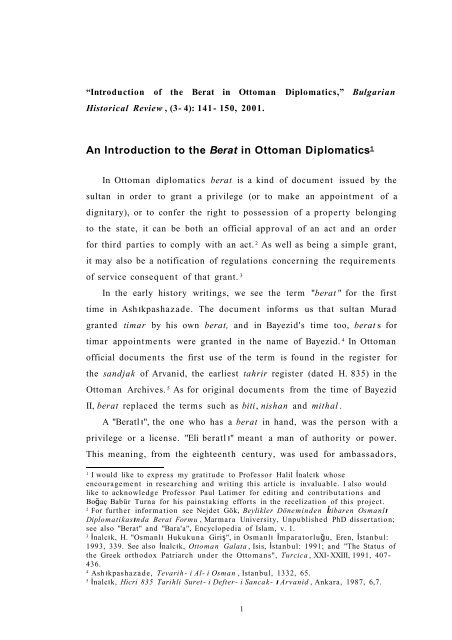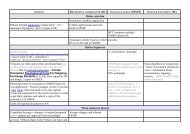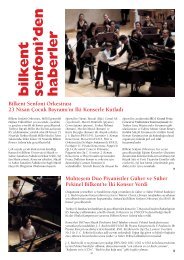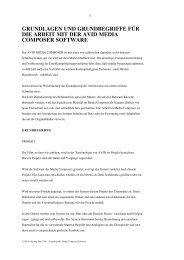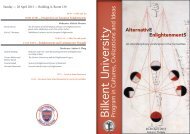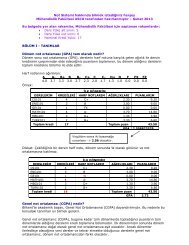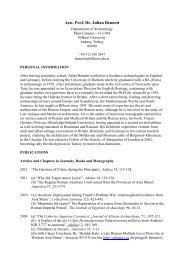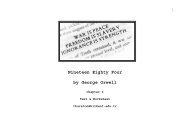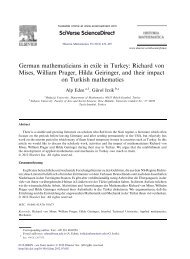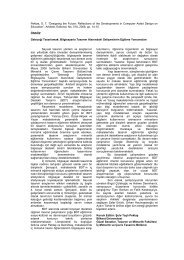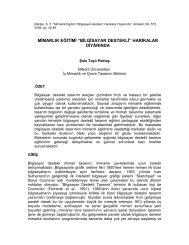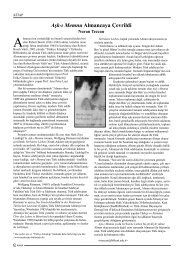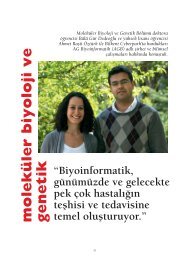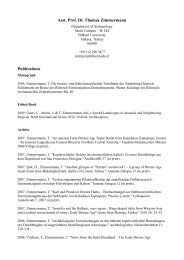The word Berat comes from the Arabic word ... - Bilkent University
The word Berat comes from the Arabic word ... - Bilkent University
The word Berat comes from the Arabic word ... - Bilkent University
Create successful ePaper yourself
Turn your PDF publications into a flip-book with our unique Google optimized e-Paper software.
“Introduction of <strong>the</strong> <strong>Berat</strong> in Ottoman Diplomatics,” Bulgarian<br />
Historical Review , (3- 4): 141- 150, 2001.<br />
An Introduction to <strong>the</strong> <strong>Berat</strong> in Ottoman Diplomatics 1<br />
In Ottoman diplomatics berat is a kind of document issued by <strong>the</strong><br />
sultan in order to grant a privilege (or to make an appointment of a<br />
dignitary), or to confer <strong>the</strong> right to possession of a property belonging<br />
to <strong>the</strong> state, it can be both an official approval of an act and an order<br />
for third parties to comply with an act. 2 As well as being a simple grant,<br />
it may also be a notification of regulations concerning <strong>the</strong> requirements<br />
of service consequent of that grant. 3<br />
In <strong>the</strong> early history writings, we see <strong>the</strong> term "berat " for <strong>the</strong> first<br />
time in Ash ıkpashazade. <strong>The</strong> document informs us that sultan Murad<br />
granted timar by his own berat, and in Bayezid's time too, berat s for<br />
timar appointments were granted in <strong>the</strong> name of Bayezid. 4 In Ottoman<br />
official documents <strong>the</strong> first use of <strong>the</strong> term is found in <strong>the</strong> register for<br />
<strong>the</strong> sandjak of Arvanid, <strong>the</strong> earliest tahrir register (dated H. 835) in <strong>the</strong><br />
Ottoman Archives. 5 As for original documents <strong>from</strong> <strong>the</strong> time of Bayezid<br />
II, berat replaced <strong>the</strong> terms such as biti, nishan and mithal .<br />
A "<strong>Berat</strong>l ı", <strong>the</strong> one who has a berat in hand, was <strong>the</strong> person with a<br />
privilege or a license. "Eli beratl ı" meant a man of authority or power.<br />
This meaning, <strong>from</strong> <strong>the</strong> eighteenth century, was used for ambassadors,<br />
1 I would like to express my gratitude to Professor Halil İnalc ı k whose<br />
encouragemen t in researching and writing this article is invaluable. I also would<br />
like to acknowledge Professor Paul Latimer for editing and contributations and<br />
Boğaç Babür Turna for his painstaking efforts in <strong>the</strong> recelization of this project.<br />
2 For fur<strong>the</strong>r information see Nejdet Gök, Beylikler Döneminden İtibaren Osmanl ı<br />
Diplomatikas ı nda <strong>Berat</strong> Formu , Marmara <strong>University</strong>, Unpublished PhD dissertation;<br />
see also "<strong>Berat</strong>" and "Bara'a", Encyclopedia of Islam, v. 1.<br />
3 İnalc ık, H. "Osmanl ı Hukukuna Giri ş", in Osmanl ı İmparatorlu ğu, Eren, İ stanbul:<br />
1993, 339. See also İnalc ık, Ottoman Galata , Isis, İ stanbul: 1991; and "<strong>The</strong> Status of<br />
<strong>the</strong> Greek orthodox Patriarch under <strong>the</strong> Ottomans", Turcica , XXI- XXIII, 1991, 407-<br />
436.<br />
4 Ash ıkpashazade, Tevarih - i Al- i Osman , Istanbul, 1332, 65.<br />
5 İnalc ık, Hicri 835 Tarihli Suret- i Defter- i Sancak - ı Arvanid , Ankara, 1987, 6,7.<br />
1
translators, <strong>the</strong>ir assistants and non- Muslim subjects of <strong>the</strong> Empire<br />
who had been granted berat . 6<br />
a. <strong>Berat</strong> in Islamic Literature<br />
In <strong>the</strong> Quran, <strong>the</strong> <strong>word</strong> appears twice as "<strong>Berat</strong>un ": First, in <strong>the</strong><br />
surah named Kamer , <strong>the</strong> Moon, ayat 43: "What, are your unbelievers<br />
better than <strong>the</strong>se? Or have you an immunity in <strong>the</strong> Scriptures? " 7 In this<br />
ayat, "beraet " is salvation, immunity or a kind of warranty. <strong>The</strong> ayat<br />
warns <strong>the</strong> unbelievers, stating that <strong>the</strong>y have to have a more powerful<br />
support than ei<strong>the</strong>r <strong>the</strong> Pharaoh's army or a <strong>Berat</strong> granting a safe-<br />
conduct to <strong>the</strong>m. It is clear that berat here is a diploma providing<br />
power or safety.<br />
<strong>The</strong> first ayat of <strong>the</strong> surah Tevbe , Repentance, is <strong>the</strong> second to<br />
contain <strong>the</strong> <strong>word</strong>. This surah, upon which <strong>the</strong> mufessir s’ comments<br />
differ, has been called Berae as well. At <strong>the</strong> beginning it is told that<br />
unbelievers are granted a truce by God and <strong>the</strong> Prophet for four<br />
months and promised that <strong>the</strong>y will be "unmolested" during that time.<br />
This comment fits in with <strong>the</strong> meaning in <strong>the</strong> surah Kamer . However,<br />
according to some o<strong>the</strong>r commentators who take into consideration <strong>the</strong><br />
rest of <strong>the</strong> surah that mentions a future war after this period of<br />
immunity, beraet means "ultimatum", or "to break off any kind of<br />
relation", or "to keep a distance between". 8 Ano<strong>the</strong>r <strong>word</strong> <strong>from</strong> <strong>the</strong><br />
same root, Beri, has generally this meaning in <strong>the</strong> Quran.<br />
As explained in Mufredat and Besair 9 , <strong>the</strong> root of beraet can mean<br />
"to get rid of, to get away <strong>from</strong> something unpleasant". Kad ı Beydavi<br />
states that <strong>the</strong> <strong>word</strong> beraet , in his tefsir of <strong>the</strong> ayat 54 in <strong>the</strong> surah<br />
Bakara , means to become purified or clarified". Becoming beri for a<br />
sick person, or for a person in debt, indicates recovery in ei<strong>the</strong>r case.<br />
6 Lewis, Bernard, "<strong>Berat</strong>l ı",<br />
EI, v. I, 1171.<br />
7 <strong>The</strong> Koran , trans. by N. J. Dawood, Penguin, London, 1990, 529.<br />
8 Suat Yıldır ım, Kur'an- ı Hakim ve Açıklamal ı Meali , İstanbul:<br />
1998, 198.<br />
9 Ragib al Isfahani, al Mufredat li Garib al Kur'an , Ebu Hayyan al Tevhidi, al Besair<br />
ve al Zahir cited in Elmal ıl ı M. H. Yazır, Hak Dini Kur'an Dili, Istanbul: 1996, v. IV,<br />
265- 67<br />
2
<strong>The</strong> person recovers <strong>from</strong> <strong>the</strong> illness, or he ceases to be in debt. In "<strong>the</strong><br />
creation of Adam out of mud", <strong>the</strong> act of berae is to create by purifying<br />
something. 10 Ano<strong>the</strong>r example concerning this act is expressed in<br />
Mecelle as a legal term: "Absence or exemption of obligation or<br />
responsibility is essential". This exemption has a purity in itself and it<br />
is a consequence of <strong>the</strong> creation. Acquittal <strong>from</strong> a guilt has a similar<br />
nature, it can be considered as a matter of "purity". However, in <strong>the</strong><br />
ayat, <strong>the</strong> term is based on a political and diplomatic concern. Abu Bakr<br />
Razi argues that according to <strong>the</strong> Quran beraet refers to breaking off<br />
any kind of relationship, and removing someone <strong>from</strong> <strong>the</strong> protection of<br />
an agreement. 11 F. Razi, too, explains <strong>the</strong> term as abolition of an<br />
immunity. 12 Thus, it is possible to observe two different meanings<br />
present at <strong>the</strong> same time. But its definition in respect to legal<br />
terminology, - especially international law- , seems to be more<br />
appropriate. It is ra<strong>the</strong>r <strong>the</strong> breaking off of a relationship than<br />
becoming pure and faultless, and this act of breaking off of a<br />
diplomatic relationship requires a declaration of war that consists of a<br />
truce beforehand.<br />
It is obvious that this ayat has <strong>the</strong> style of a diplomatic letter<br />
consisting of an intitulatio , where <strong>the</strong> name or rank of <strong>the</strong> person<br />
issuing <strong>the</strong> document is mentioned and of an inscriptio , where <strong>the</strong><br />
name of <strong>the</strong> addressee is mentioned. Here what we have is not just an<br />
ordinary letter, but all <strong>the</strong> requirements of an official notification, an<br />
ultimatum or an abolition of a treaty:<br />
"A declaration of immunity (berat) <strong>from</strong> God and His apostle to <strong>the</strong><br />
idolaters with whom you have made agreements. For four months you<br />
shall go unmolested in <strong>the</strong> land. " 13<br />
Ano<strong>the</strong>r example is one of <strong>the</strong> sacred times for Muslims which is<br />
10 al Beydavi, Envar al Tenzil ve Esrar al Te'vil , vol I, 81, see also al Zebidi, 45.<br />
11 al Cessas, Ahka m al Kur'an , IV, 264.<br />
12 Fahreddin Razi, Mefatih al Gayb , XVI, 225.<br />
13 <strong>The</strong> Koran , 186.<br />
3
called <strong>the</strong> night of <strong>the</strong> berat . <strong>The</strong> main idea is <strong>the</strong> same: a kind of<br />
immunity or privilege for believers who want to be exempted, and<br />
forgiven. According to <strong>the</strong> ayat, <strong>the</strong> truce of four months granted to <strong>the</strong><br />
idolaters was a privilege of <strong>the</strong> same kind. So can be <strong>the</strong> berat of<br />
Ottoman diplomatics as a legal diploma.<br />
By examining <strong>the</strong> surah Repentence we find certain basics about<br />
<strong>the</strong> berat :<br />
1. <strong>Berat</strong> is granted only to <strong>the</strong> idolaters with whom a treaty has<br />
been concluded. It will be valid as long as <strong>the</strong>y remain loyal. <strong>The</strong><br />
prerequisite of <strong>the</strong> berat is an established treaty.<br />
2. <strong>The</strong> person or party who grants a berat is more powerful than<br />
<strong>the</strong> o<strong>the</strong>r party. One of <strong>the</strong> parties is <strong>the</strong> superior, and <strong>the</strong> o<strong>the</strong>r is <strong>the</strong><br />
inferior. Thus, this is a matter of "donation".<br />
3. In return for granting a berat <strong>the</strong> subordinate party will have<br />
responsibilities.<br />
4. <strong>Berat</strong> concerns third parties as well. (<strong>The</strong> surah , Repentance,<br />
addresses all Muslims, and <strong>the</strong>y are expected to obey).<br />
5. <strong>Berat</strong> is granted for a certain period of time that depends on <strong>the</strong><br />
manner of <strong>the</strong> subordinate party.<br />
6. <strong>The</strong> absence of besmele , <strong>the</strong> invocation "In <strong>the</strong> name of God, <strong>the</strong><br />
Merciful, <strong>the</strong> Compassionate ", is treated by some scholars as<br />
remarkable. In berat s, unlike o<strong>the</strong>r Ottoman documents, <strong>the</strong>re is no<br />
besmele , <strong>the</strong> invocation.<br />
b. <strong>Berat</strong> and Berit<br />
Taking <strong>the</strong> connection between <strong>Arabic</strong> and Hebrew into<br />
consideration it can be argued that <strong>the</strong>re is a relationship between<br />
berat and <strong>the</strong> Hebrew <strong>word</strong> berit that indicates a similar meaning. It is<br />
a widely known fact that, since <strong>the</strong> first year of <strong>the</strong> Hegira, many works<br />
have been written concerning <strong>the</strong> <strong>word</strong>s adapted by <strong>Arabic</strong> <strong>from</strong><br />
4
different Semitic languages. 14 <strong>The</strong> Hebrew root b- r- a, as in <strong>Arabic</strong>, is<br />
<strong>the</strong> verb "to create". 15 <strong>The</strong> <strong>word</strong> berit , derived <strong>from</strong> <strong>the</strong> same root,<br />
means covenant, agreement or obligation between individuals, groups<br />
or ruler and subjects. 16 In <strong>the</strong> Old Testament <strong>the</strong>re are covenants<br />
established between God and man. Noah and his followers were<br />
granted a berit in order to prevent a second flood and a bow was put<br />
onto a cloud (a rainbow) as a sign of <strong>the</strong> covenant (Genesis, 6/18, 19;<br />
9/12, 15, 16). Abraham and <strong>the</strong> Israelites, too, were granted a berit in<br />
which <strong>the</strong>y were expected to obey <strong>the</strong> divine rules, to circumcise <strong>the</strong>ir<br />
sons, and to avoid adultery and indecency (7/8). In return, <strong>the</strong> land of<br />
Cana'an was promised to <strong>the</strong>m by God (Genesis, 13/15, 17; 15/18;<br />
17/2 - 8). When <strong>the</strong>y violated <strong>the</strong> covenant God punished <strong>the</strong>m<br />
(Deuteronomy, 29/25; I. Kings, 19/10; II. Chronicles, 12/1; Jeremiah,<br />
22/9; Daniel, 2/30; Deuteronomy, 17/2; Joshua, 7/11, 23/16; Judges,<br />
2/10; Psalms, 132/12). However <strong>the</strong>y were forgiven <strong>the</strong>n, and ano<strong>the</strong>r<br />
covenant was established (Jeremiah, 31/31 - 34; 32/37 - 42). From <strong>the</strong>n<br />
on God would be <strong>the</strong> Lord of <strong>the</strong>m, and <strong>the</strong> Israelites would be <strong>the</strong><br />
people of <strong>the</strong> Lord (Jeremiah, 31/34). 17 <strong>The</strong>refore this covenant<br />
involved <strong>the</strong> commitment of <strong>the</strong> Israelites, known as sons of <strong>the</strong><br />
covenant. 18<br />
Bari, one of <strong>the</strong> names of God, has <strong>the</strong> same root as <strong>the</strong> <strong>word</strong><br />
berat. 19 Bari is <strong>the</strong> Creator who has no obligation, no charge, who has<br />
no similarity to his creatures' characteristics, who established <strong>the</strong><br />
14 Ibn Abbas, Garib al Kur'an . This pamphlet, revised by Ata b. Edu Rebah, is in <strong>the</strong><br />
Süleymaniye Library, section "Atıf Efendi", number 2815/ 8, page 102- 107.On this<br />
work, see İ. Cerraho ğlu, İ lahiyat Fakültesi Dergisi , Ankara <strong>University</strong>, XXII, 23, also<br />
Ebu Mansur al Cevaliki, al Mu'arreb. (<strong>The</strong> revised edition of this work by<br />
Cemaleddin Abdullah b. Muham me d al Uzri, a 15 th century scholar, is not<br />
published yet.<br />
15 <strong>The</strong> Dictionary of Classical Hebrew , Sheffield Academic Press, Sheffield: 1995, II,<br />
258.<br />
16 ibid., 264.<br />
17 A. Küçük, "Ahid- Dinler Tarihi", Diyanet İ slam Ansiklopedisi , Diyanet Vakfı<br />
Yayınevi, İstanbul:<br />
1992, v.I, 533.<br />
18 A. Unterma n, "Berit" and "Covenant" in Dictionary of Jewish- lore and Legend ,<br />
London: 1961.<br />
19 B. Topalo ğlu, "Bari", Diyanet İ slam Ansiklopedisi , v. 5, 73.<br />
5
universe in a perfect accord and unity. Some scholars claim that <strong>the</strong><br />
<strong>word</strong> bari which appears twice in <strong>the</strong> Quran, is undoubtedly adapted<br />
<strong>from</strong> Hebrew and that <strong>the</strong> Prophet did not use <strong>the</strong> term in a particular<br />
meaning. 20 But according to Topalo ğ lu this <strong>word</strong> existed in various<br />
forms indicating God <strong>from</strong> pre- Islamic times and it was only natural to<br />
find similar <strong>word</strong>s defining <strong>the</strong> divinity in major religions. 21<br />
Never<strong>the</strong>less, both arguments support <strong>the</strong> idea of <strong>the</strong> existence of a<br />
relationship between berat and berit.<br />
<strong>The</strong> <strong>word</strong> <strong>Berat</strong> <strong>comes</strong> <strong>from</strong> <strong>the</strong> <strong>Arabic</strong> <strong>word</strong> "bara’a". In Ottoman<br />
Turkish it was used without <strong>the</strong> hemze . <strong>Berat</strong> is <strong>the</strong> infinitive form<br />
derived <strong>from</strong> <strong>the</strong> verb "b- ra- e". 22 <strong>The</strong> term itself is related to some<br />
o<strong>the</strong>r <strong>word</strong>s that come <strong>from</strong> <strong>the</strong> same root and have specific meanings<br />
in particular contexts.<br />
In major <strong>Arabic</strong> dictionaries, <strong>the</strong> main meaning of its root is given<br />
as follows: B- ra- e, when used for God, means "to create without a<br />
model or sample" Al- Bari a <strong>word</strong> derived <strong>from</strong> <strong>the</strong> same root, means<br />
<strong>the</strong> Creator, having no similarity to what He has created and composing<br />
<strong>the</strong> whole universe without disorder. 23 In <strong>the</strong> Quran it can be seen that,<br />
in general, <strong>the</strong> verb b- ra- e is used for <strong>the</strong> creation for those who have<br />
spirit, while for things such as <strong>the</strong> earth or heaven, <strong>the</strong> verb halaka is<br />
used. <strong>The</strong> idea of distance or transcendence expressed in Al- Bari is<br />
appropriate to berat .<br />
Beside <strong>the</strong> meanings "to create" or "creation", it has o<strong>the</strong>r meanings:<br />
to become clarified, purified, to gain safety, to have immunity or<br />
privilege, to be acquitted of a debt or guilt, to recover <strong>from</strong> an illness,<br />
to be exempted <strong>from</strong> a responsibility. 24 According to <strong>the</strong> root, "to be far<br />
20 D. B. MacDonald, "Allah", İ slam Ansiklopedisi , Milli Eğitim Bakanl ığı, İ stanbul,<br />
1949, v.I, 363.<br />
21 B. Topalo ğlu,<br />
73.<br />
22 Firuzabadi, al Kamusu al- Muhit , vol. I, Istanbul, 1230, al Zebidi, Tac al- Arus , vol.<br />
I, 44, Ibn Manzur, Lisan al Arabi al Muhit , vol I, 182.<br />
23 Firuzabadi, 8. Ibn Manzur, 22.<br />
24 Ibn Manzur, 182- 83. Al Cevheri, Sihah , vol I, 11. Al Zebidi, 44,45. Firuzabadi, 8-<br />
9. Ibrahim Mustafa, Mucem al Vasit , vol I 45- 46.<br />
6
away, apart, distant" is also correct for <strong>Berat</strong> s. For <strong>the</strong> person who is<br />
granted a <strong>Berat</strong> , be<strong>comes</strong> exalted by obtaining a privilege. Thus he is<br />
"purified" or "exempted" <strong>from</strong> an imperfection.<br />
We find <strong>the</strong> term in hadith. It is used to indicate <strong>the</strong> notion of<br />
exemption, release (<strong>from</strong> a sin), or dissociation. 25<br />
In <strong>the</strong> <strong>the</strong>ory of law berat has an important place. Beraet- i asliyye ,<br />
<strong>the</strong> principal beraet, is interpreted as innocence, or absence of<br />
accusation or responsibility. In criminal law this means that if <strong>the</strong>re is<br />
no proof to <strong>the</strong> contrary, <strong>the</strong> person is guiltless. In <strong>the</strong> law of obligation<br />
it is an exemption <strong>from</strong> a debt. Mecelle, <strong>the</strong> Ottoman civil code, states<br />
that <strong>the</strong> principal "freedom <strong>from</strong> obligation is essential" and describes<br />
<strong>the</strong> same understanding in a wider sense. In <strong>the</strong> time of Ömer, <strong>the</strong><br />
second Caliph, <strong>the</strong> non- Muslim subject who had already paid <strong>the</strong>ir tax<br />
was granted a berat in order to prevent abuses. 26 In commercial law,<br />
bay al berae , makes <strong>the</strong> seller immune <strong>from</strong> any obligation if <strong>the</strong> sold<br />
object has defects. 15 th of Shaban , night of <strong>the</strong> berat, having a sacred<br />
importance, is considered as a general immunity, a release <strong>from</strong> sin or<br />
guilt. This night is also called as night of sakk , <strong>the</strong> night of <strong>the</strong><br />
diploma. 27<br />
Equivalents of <strong>the</strong> <strong>Berat</strong> in <strong>the</strong> Ottoman Empire<br />
In Ottoman diplomatics <strong>the</strong> use of <strong>the</strong> <strong>word</strong> berat became<br />
widespread <strong>from</strong> <strong>the</strong> last quarter of <strong>the</strong> fifteenth century onwards.<br />
Before that, many <strong>word</strong>s expressed <strong>the</strong> same meaning, while some of<br />
<strong>the</strong>se were used interchangeably in <strong>the</strong> same document until <strong>the</strong> end of<br />
<strong>the</strong> Empire. <strong>The</strong>se are: biti, bitik, hüküm, mithal, tevki, kitab, nishan,<br />
ferman etc.<br />
25 Ebu Davud, "Eyman", 9; Nesai, "Eyman" cit. in A. Bardakoglu, "Beraet", Diyanet<br />
Islam Ansiklopedisi , V/470- 1.<br />
26 Hamidullah, M., Mecmuat al Vesaik al Siyasiyye , Cairo, 1956: number 43.<br />
27 Elmal ıl ı , VII/67- 68. See also H. Ünal, "<strong>Berat</strong> Gecesi", Diyanet İ slam Ansiklopedisi ,<br />
v. 5, 475- 76.<br />
7
a. <strong>The</strong> Use of Biti, Bitik<br />
In documents written in <strong>the</strong> second half of <strong>the</strong> fourteenth century<br />
and in <strong>the</strong> fifteenth century, <strong>the</strong> <strong>word</strong> biti had different meanings, such<br />
as letter, <strong>word</strong>, berat, hüküm, nishan, mithal . We do not know about<br />
<strong>the</strong> etymology of <strong>the</strong> <strong>word</strong> biti and its root bitimek. However, it is<br />
assumed that <strong>the</strong> <strong>word</strong> <strong>comes</strong> <strong>from</strong> a Chinese <strong>word</strong> "pi- bit/piet " which<br />
means writing- brush. 28 In various dialects of <strong>the</strong> Turkish language, biti,<br />
bitik, bitiv, bituv, buti all mean writing or letter. Bitiglig (<strong>the</strong> owner of a<br />
written document) and bitigu (ink) come <strong>from</strong> <strong>the</strong> same root. 29 Bitig tili<br />
is language of a book; bitig ostasi, a teacher; ulug bitikci (in eastern<br />
dialect) <strong>the</strong> head of <strong>the</strong> clerks. 30<br />
Yusuf Has Hacib mentions an officer "bitikci, bitikci ılı mga " who<br />
conducted <strong>the</strong> correspondence of <strong>the</strong> sultan and who was <strong>the</strong> confidant<br />
31 According to Kasgarli Mahmud "ilimga " was <strong>the</strong> person who wrote<br />
<strong>the</strong> letters of <strong>the</strong> sultan in Turkish. 32 Fuat Köprülü argues, in his<br />
explanation of <strong>the</strong> <strong>word</strong> "nishan ", that official documents written in <strong>the</strong><br />
fourteenth and fifteenth century are called "biti" instead of "nishan ".<br />
<strong>The</strong> documents belonging to <strong>the</strong> earliest Ottoman sultans, published by<br />
Kraelitz in TOEM, prove this claim. In <strong>the</strong> waqf registers of <strong>the</strong> time,<br />
says Köprülü, "emirname ", decrees by <strong>the</strong> sultan or prince, were called<br />
"nishan", while those by begs , beglerbeg s and kadi s were called biti.<br />
Terms in <strong>the</strong> registers such as "örüncek bitisi" and "gökce ören bitisi"<br />
are as yet unexplanied. Köprülü also accepts that <strong>the</strong> <strong>word</strong> biti is<br />
derived <strong>from</strong> "pit " which means brush in Chinese. 33<br />
28 Şiratori, Sinologische Beitrage zur Geschichte der Türkvölker , Petersburg: 1902,<br />
II,16. Also A. von Gabain, Altürkische Gram m atik, Leipzig; 1942, 303. Mecdud<br />
Mansuro ğlu, "Bitikçi", İ slam Ansiklopedisi , v.2, 657. M. İpşirli, "Bitikçi", Diyanet<br />
İ slam Ansiklopedisi , v. 6, 225.<br />
29 For more information see G. Doerfer, Turkische und Mongolische Elemente im<br />
Neupersischen , Wiesbaden: 1965, II/262 - 64.<br />
30 M. Mansuro ğlu,<br />
657.<br />
31 Kemal Eraslan (ed.), Kutadgu Bilig , III, İstanbul:<br />
1979, 93- 95.<br />
32 Divan- i Lugat al Turk , İstanbul:<br />
1333 (1918), I/127.<br />
33 F. Köprülü, Bizans Müesseselerinin Osmanl ı Müesseselerine Tesiri , İ stanbul: 1981,<br />
62- 3.<br />
8
Ano<strong>the</strong>r argument about <strong>the</strong> origin of <strong>the</strong> <strong>word</strong> is put forward by<br />
Ipsirli. According to him, many new <strong>word</strong>s were derived <strong>from</strong> <strong>the</strong> verb<br />
"bitimek ", "to write": "bitigu ", pencil; "bitig/bitik ", writing, inscription,<br />
document, letter, book, order, decree; "bitikci", clerk; "bitigli", owner of<br />
<strong>the</strong> document; "bitiklik ", writing material. 34<br />
Kafesoğ lu says that, some information was found in <strong>the</strong> Chinese<br />
annals about how Turks communicated and prepared official<br />
documents by drawing certain signs on wax with an arrow or by<br />
carving on sticks. 35 Thus, adds Kafesoğ lu, <strong>the</strong> origin of Turkish writing<br />
should be examined in a Turkish ra<strong>the</strong>r than Chinese context. With this<br />
in mind, some scholars study Turkish seals on this question. 36 Ano<strong>the</strong>r<br />
point Kafesoğ lu put forward was <strong>the</strong> question of <strong>the</strong> origin of <strong>the</strong> <strong>word</strong><br />
bitig . He refused <strong>the</strong> assumption that <strong>the</strong> <strong>word</strong> was based on Chinese.<br />
To uphold his argument, he noted that Turkish was not a language that<br />
was written with a brush, but was a kind of "inscription language"<br />
written with steel implements on firm surfaces. Secondly, <strong>the</strong> <strong>word</strong><br />
bitig, brush, did exist in Uighur dialect, but underwent some changes<br />
both in formation and in meaning. <strong>The</strong> <strong>word</strong> bitig must be a noun<br />
derived <strong>from</strong> a Turkish verb bit/biç- mek . In Chinese this <strong>word</strong> is<br />
"biçi(g)". 37<br />
Yusuf Has Hacib states that <strong>the</strong> bitigi ılı mga was <strong>the</strong> officer who<br />
managed official correspondence in <strong>the</strong> Karakhanate and he was also<br />
confidant of <strong>the</strong> ruler. Hacib's verse "if you become bitigci ılı mga, keep<br />
your heart secret, don't say a <strong>word</strong> " expresses his views. 38 Ano<strong>the</strong>r<br />
account, related by Uzunçar şıl ı , reminds us of Hacib's explanation:<br />
"According to S. Sami <strong>the</strong> <strong>word</strong> beylikci is originally derived <strong>from</strong><br />
bitikci. Beylikci is <strong>the</strong> one who puts in writing important and secret<br />
34 Kafeso ğlu, İ., Türk Milli Kültürü , İstanbul:<br />
1989, 324.<br />
35 ibid.<br />
36 ibid., 324.<br />
37 ibid., 324.<br />
38 Resat Genç, Karahanli Devlet Teskilati , İstanbul:<br />
1981, 258- 59.<br />
9
matters in official form sent by reis al- küttab (chief of clerks). 39<br />
In former Turkish states, bitekci, in Tabgach, bitekci and ılı mga and<br />
damgacı , in Goktürk, Turgis and Uighurs, tugracı in Oghuz, functioned<br />
as a class of clerks responsible for official correspondence. Documents<br />
had <strong>the</strong> imperial stamp or seal (tamga, tugra ) of <strong>the</strong> khakan. 40 We<br />
know of <strong>the</strong> existence of <strong>the</strong> same posts (bitikci and ılı mga ) in <strong>the</strong><br />
Karakhanate, considered as <strong>the</strong> first Turkish- Muslim dynasty in<br />
Turkistan between 840 and 1212. <strong>The</strong> military was controlled by a<br />
divan, a council of state, like <strong>the</strong> divan under <strong>the</strong> Seljukids, and this<br />
institution had registers covering not only <strong>the</strong> payments and monthly<br />
salaries of soldiers namely "ay bitigi", but also any kind of change in<br />
<strong>the</strong>ir positions. 41 Probably <strong>the</strong> <strong>word</strong>s bitigçi and bitikçi passed to <strong>the</strong><br />
Mongols <strong>from</strong> <strong>the</strong> Turks through <strong>the</strong> Uighur clerks. In Mongolian <strong>the</strong>re<br />
were similar <strong>word</strong>s such as biçigü (to write), biçikçi (clerk) and biçig- ün<br />
tüsimel (an officer in <strong>the</strong> chancery). 42 Uighur influence had important<br />
place in <strong>the</strong> organisation of <strong>the</strong> Mongol Empire and we have many legal<br />
and financial terms that reflect this. 43 For <strong>the</strong> Ilkhanids, (1256- 1344),<br />
Ulug Bitikçi was <strong>the</strong> head of <strong>the</strong> chancery office. He was <strong>the</strong> one who<br />
was responsible for writing any official document such as a decree,<br />
diploma, or letter issued by <strong>the</strong> council of state as well as for guiding<br />
<strong>the</strong> clerks under him called bitikçi or bahshi . 44<br />
In Turk- ruled states in Egypt too, <strong>the</strong> <strong>word</strong> bitikçi that meant clerk<br />
existed: "When Izzeddin Ahmet died he was one of <strong>the</strong> bitikçis". 45<br />
<strong>The</strong> influence of <strong>the</strong> Ilkhanids, as in many fields, was undoubtedly<br />
39 İ. Hakk ı Uzunçar şıl ı, Merkez ve Bahriye Teşkilat ı, Ankara: 1988, 39.<br />
40 Kafeso ğlu,<br />
266.<br />
41 R. Genç, “Karahanl ılar", Doğuştan Günü m ü ze Büyük İ slam Tarihi , İ stanbul: 1992,<br />
VI, 174- 5.<br />
42 W. Schmidt, Mongolish- Deutsch - Russisches Wörterb , Petersburg: 1835, 109, cited<br />
in M. Mansuro ğlu,<br />
657.<br />
43 Ahmet Cafero ğlu, "Uygurlarda Hukuk ve Maliye Istılahlari", Türkiyat , v.4, 1- 43;<br />
For Chinese influence on <strong>the</strong> Uighurs see Uzunçar şıl ı, Osmanl ı Devletine Medhal ,<br />
Türk Tarih Kurumu, Ankara: 1975, 174.<br />
44 Uzunçar şıl ı, 219; for "Bahşi" see Köprülü, "Bahşi", İ slam Ansiklopedisi , v.2, 233-<br />
38.<br />
45 Uzunçar şıl ı,<br />
187.<br />
10
important on <strong>the</strong> art of official writing in <strong>the</strong> Ottoman State, in o<strong>the</strong>r<br />
<strong>word</strong>s, on Ottoman diplomatics. <strong>The</strong> style and method of <strong>the</strong> Ilkhanids<br />
was applied by <strong>the</strong> Ottomans, especially <strong>the</strong> introductory protocol,<br />
sanction and final protocol in official documents such as fermans,<br />
(orders dispatched by <strong>the</strong> sultans), and berats. 46 <strong>The</strong> Seljukids<br />
including <strong>the</strong> Seljukids of Rum had sahib- i tugra, tugrai , nishanc ı and<br />
pervance/pervane as holders of <strong>the</strong> imperial monogram. <strong>The</strong>se officers'<br />
duty was to write down fermans, berats, as well as land registers. <strong>The</strong><br />
Karakoyunlus and Akkoyunlus also had a divan in which pervançi did<br />
<strong>the</strong> same duty.<br />
<strong>The</strong> <strong>word</strong> biti was used by <strong>the</strong> Anatolian principalities and <strong>the</strong><br />
Ottoman State until <strong>the</strong> reign of Bayezid II. In <strong>the</strong> Arvanid register<br />
belonging to <strong>the</strong> time of Murad II we see <strong>the</strong> <strong>word</strong> many times.<br />
According to Halil İnalc ık 47 "<strong>The</strong> terminology and diplomatic rules in<br />
<strong>the</strong> first documents issued by <strong>the</strong> state and of customary- sultanic<br />
nature give clear demonstration of <strong>the</strong> continuation of <strong>the</strong> Turco- Iran<br />
tradition in official writing. <strong>The</strong> term biti was rooted in <strong>the</strong> Uighur<br />
influence expanded during <strong>the</strong> Ilkhanid sovereignty in Iran and<br />
Anatolia. We know that <strong>the</strong>re were clerks who wrote excellently in<br />
Uighur in <strong>the</strong> divan of Mehmed <strong>the</strong> Conqueror, but instead of bitikçi<br />
(clerk) <strong>the</strong> Ottomans used <strong>the</strong> term yazı cı".<br />
48<br />
b. O<strong>the</strong>r terms for <strong>Berat</strong><br />
Before <strong>the</strong> use of berat, hükm was a term with <strong>the</strong> same meaning.<br />
Hükm is literally a command, order, decision, power, supremacy. It can<br />
also mean to act as kadi , or, more generally, to influence something. 49<br />
Written orders of <strong>the</strong> sultans on any issue or duty are called hükm - i<br />
46 See Mehmed b. Hindu şahi, Düstur al Katib fi Ta'yin al Meratib , in <strong>the</strong> Köprülü<br />
Library, İstanbul, number 1241. See also Uzunçar şıl ı, Medhal , 220.<br />
47 İnalc ık, "Reisü'l- küttab", İ slam Ansiklopedisi , v. 9, 672.<br />
48 <strong>The</strong> <strong>word</strong> "yazıc ı " still exists in contemporary Uzbek- Turkish and also in some<br />
o<strong>the</strong>r turkic dialects as "yazucuv".<br />
49 Osmanli- Türkçe Ansiklopedik Büyük Lügat , Türdav, Istanbul: 1981, I, 822.<br />
11
hümayun , an imperial order. Regardless of <strong>the</strong> office which issued <strong>the</strong><br />
order, all sultanic documents were generally considered as hükm . <strong>The</strong><br />
register covering orders concerning any financial issue was called "<strong>the</strong><br />
register for financial hükms (orders). A Hükm sent to a governor or an<br />
administrator was a ferman , if it was for an appointment or privilege,<br />
it was a berat or ruus . <strong>The</strong>re are some hükm s with tuğ ra , <strong>the</strong> imperial<br />
monogram, named "clean ahkam - i sherife (respected orders) with<br />
nishan- i hümayun (imperial monogram)". 50 In this kind of document<br />
some places were blank in order to be filled in when necessary. Thus,<br />
according to subject and work, hükm s were given names like ferman,<br />
nishan, berat, tevki', menshur . <strong>The</strong> terms such as hükm - i hümayun,<br />
hükm - i sherif, hükm - i cihan- ara, hükm - i cihan muta, hükm - ü vacibi'l-<br />
imtisal define <strong>the</strong> hükm as a command or a decree. <strong>The</strong> term ferman ,<br />
except in <strong>the</strong> early times, was decisively adopted by Ottoman<br />
diplomatics. In <strong>the</strong> Arvanid Register, <strong>the</strong> earliest land register available<br />
in <strong>the</strong> Ottoman Archives (h 835- 1432), we notice terms repeatedly<br />
used, such as mektub, berat, berat of pasha, biti of pasha, biti, berat of<br />
sultan, biti of beg (governor), order of sultan. <strong>The</strong> <strong>word</strong> pervane was<br />
very rare. Biti and berat were used with <strong>the</strong> same meaning for pashas<br />
and begs, while biti was not used for <strong>the</strong> sultan. Instead, we have biti of<br />
sultan , or hükm of sultan . 51 On <strong>the</strong> o<strong>the</strong>r hand, what <strong>the</strong> register means<br />
by "<strong>the</strong> existence of a hükm by <strong>the</strong> sultan" is, in fact, nothing but a<br />
berat. In <strong>the</strong> same register, as a substitute for "hükm by <strong>the</strong> sultan", we<br />
find "berat by <strong>the</strong> sultan". 52<br />
<strong>The</strong> terms mithal and tevki' have <strong>the</strong> same meaning. In <strong>the</strong><br />
Seljukids of Rum a mithal is a document issued not by <strong>the</strong> sultan but<br />
50 See Hoca Saadeddin, Tacu't- Tevarih , II, 322, for <strong>the</strong> letter sent by Selim I to<br />
İ dris- i Bitlisi dated h. 921/1515, concerning <strong>the</strong> grant of sanjaks, administrative<br />
units, to <strong>the</strong> begs in Diyarbakir who remained loyal to <strong>the</strong> sultan. In <strong>the</strong> letter he<br />
noticed that <strong>the</strong>y were sent a clean "ahkam - i sherife with nishan - i hümayun and<br />
tuğ ra ".<br />
51 nd<br />
İnalc ık (ed.), Hicri 835 Tarihli Suret- i Defter- i Sancak - i Arvanid , 2 edition,<br />
Ankara: 1987, 69, 77.<br />
52 İnalc ık,<br />
(1987), 72, 197, 198.<br />
12
y high officials such as viziers to order or advise lower officials. <strong>The</strong><br />
Ottomans interchangeably used <strong>the</strong> terms mithal and ferman, nishan,<br />
tevki', or even tuğ ra . <strong>The</strong> documents generally begin with a formula:<br />
"<strong>the</strong> reason why this respected imperial tevki' is written is that ..." or<br />
"<strong>the</strong> reason why this unique mithal and ferman should be obeyed is<br />
that ...". In some fermans, mithal and nishan have <strong>the</strong> same meaning:<br />
"Nishan- i hümayun and mithal- i meymun " (imperial nishan and sacred<br />
mithal ). 53<br />
<strong>The</strong>re are many examples in early Ottoman works on writing (i.e.<br />
Menahic ) which demonstrate that <strong>the</strong> <strong>word</strong>s such as kitab, kitab- i<br />
hümayun, mithal, tevki', nishan were used as substitutes for one<br />
ano<strong>the</strong>r in <strong>the</strong> fifteenth century. This may be a result of a trial period in<br />
constructing formulae. Thus, it is possible to see <strong>the</strong> terms used<br />
interchangeably in <strong>the</strong> same document. In <strong>the</strong> nishan of Süleyman<br />
Çelebi, dated h. 815/1412, for example, in <strong>the</strong> beginning "kitab" is used<br />
, <strong>the</strong>n "tevki'" and finally "mektub" with <strong>the</strong> same meaning. 54<br />
Ano<strong>the</strong>r example is <strong>the</strong> biti of Musa Çelebi, dated h. 815/1412, in<br />
which biti, mektub and nishan are used. 55 <strong>The</strong> nishan of Mehmed I<br />
dated h. 823/1420 uses <strong>the</strong> terms mithal, tevki' and ferman . 56 In some<br />
berat s we observe that <strong>the</strong> term kitab (like hükm ), in accordance with<br />
Islamic tradition, had a comprehensive meaning that covered any kind<br />
of document. 57<br />
Yarlık, Yarl ığ<br />
We know that amongst <strong>the</strong> Mongols and in Mongol originated states<br />
53 Uzunçar şıl ı, "Tuğra ve Pençeler", Belleten , Ankara: 1941, XVII- XVIII, 130- 31.<br />
54 Topkap ı Saray ı Müzesi Arşivi, <strong>The</strong> Archives of Sinan Paş a, number 152; Tahsin<br />
Öz, Tarih Vesikalari , I, number 4; P. Wittek, Wiener Zeitschrift für die Kunde des<br />
Morgenlandes , LVII, 102.<br />
55 T. Gökbilgin, "XV- XVI.asirlarda Edirne ve Paş a Livasi", Istanbul <strong>University</strong>,<br />
Edebiyat Fakültesi, Istanbul, 1952: 172.<br />
56 Feridun Bey, Mecmua - i Munş eatu's- Selatin , Takvimhane - i Amire [Istanbul] 1274-<br />
75: I, 166.<br />
57 For more information on uses of this kind see M. Hamidullah, Al Vesaik al<br />
Siyasiyye , doc. number V, VII, XVII.<br />
13
such as <strong>the</strong> Golden Horde and <strong>the</strong> Crimean and Kazan Khanates, yarlı k<br />
was <strong>the</strong> name of letters sent to foreign rulers and, in particular, of<br />
diplomas granting privileges. 58 Yarlı k must have been in <strong>the</strong> form of a<br />
sultanic order, namely a ferman. Besides it is a fact that <strong>the</strong>se<br />
documents have been clearly identified as "yarlık". 59<br />
According to Ilkhanid traditions official documents (amsele) and<br />
laws (carluk, yarlug, ferman) were prepared by officials called bitikçi<br />
under <strong>the</strong> control of <strong>the</strong> head of all clerks, namely <strong>the</strong> münshi- i divan-<br />
ı büzürg and all <strong>the</strong> documents had <strong>the</strong> imperial seal "paiza". In <strong>the</strong><br />
chancery (divan- ı büzürg- i İ lhanî ), were sections for Mongolia, Persia,<br />
north China, Tibet and Tangut. <strong>The</strong>refore each document was written<br />
in <strong>the</strong> original language of its destination. 60 <strong>The</strong> Ilkhanids applied <strong>the</strong><br />
traditional Mongol approach and at <strong>the</strong> beginning of a document, used<br />
<strong>the</strong> formula "Mengi tengri küçündür", (in <strong>the</strong> power of God), which<br />
would become, with Islam, Besmele. <strong>The</strong>y <strong>the</strong>n simply indicated <strong>the</strong><br />
addressee and addresser in a formula (such as "by <strong>the</strong> order of .... to<br />
....") and used red (kızıl tamga) or black (kara tamga) seals. 61<br />
<strong>The</strong> rulers of <strong>the</strong> Golden Horde used <strong>the</strong> term "yarlı k" for <strong>the</strong>ir<br />
orders, especially concerning <strong>the</strong> making of coin, - "yarlug- ı hümayun"<br />
or "hükm - i hümayun". 62 Later on, this term passing through <strong>the</strong><br />
58 In Uigur documents yarlı k is <strong>the</strong> order of <strong>the</strong> sultan. In Divan- ı Lügat al- Türk<br />
yarl ığ is a written order of <strong>the</strong> sultan. (See "Uygurlarda Hukuk ve Maliyet<br />
Istılahlar ı", Türkiyat Mecmuası , IV, 32.) Later "nishan" replaced yarl ığ and<br />
sometimes it was called "Aldamga". According to Ali Şir<br />
Nevai, in <strong>the</strong> 15 th century<br />
Mongols used "nishan", "mühür", "tuğra" instead of "yarl ığ ", "basma", and "alamet".<br />
However <strong>the</strong> Ottomans used "nishan" as berat, yarl ığ, ferman and even tuğ ra. In<br />
fermans "nishan" means berat as well as ferman and yarl ığ.<br />
59 Yarlığ of <strong>the</strong> Toktam ış Khanate, 21- 23: "Alt ı nişanl ık yarlı k tuttuk"; yarlı k of <strong>the</strong><br />
Timur Kutluk Khanate, 23,24: "Altın nişanl ık al tamgal ık yarlı k bildirildi"; yarl ı k of<br />
<strong>the</strong> Hac ı Giray Khanate, 34: "Bu yarl ığın ı "; 51: Altın nişanl ı al tamgal ı yarlığ<br />
birdimiz". But bitiks do not always have <strong>the</strong> term biti or bitik. See first and second<br />
letter of Mengi giray Khan, 84- 88. In <strong>the</strong>se documents we see <strong>the</strong> terms<br />
"tahiyyetname" and "mektub". <strong>The</strong>se bitiks actually are like Ottoman name - i<br />
hümayu n , sultanic letter. See A. N. Kurat, Topkap ı saray ı Müzesi Arşivindeki Altı n<br />
Ordu, Kırım veTürkistan Hanlar ına Ait Yarlı k ve Bitikler , İstanbul,<br />
1940, 4.<br />
60 Nadir Devlet, " İlhanl ılar", Doğuştan Günü m ü ze Büyük İ slam Tarihi , IX, 82- 83.<br />
61 ibid.<br />
62 ibid. (quoted <strong>from</strong> B. Spuler, Die Goldene Horde , Die Mongolen in Russland ,<br />
1223- 1502, 267- 270.)<br />
14
İ lkhanids, was used by <strong>the</strong> Anatolian Seljukids, Karaoyunlu, Akkoyunlu<br />
and, though rarely, in <strong>the</strong> Mamluks. As to <strong>the</strong> Ottomans, <strong>the</strong> term was<br />
not used as a separate document category, but in berats and fermans<br />
as a formula such as "yarlığ- ı beli ğ".<br />
Menshur was ano<strong>the</strong>r widely used term. It was <strong>the</strong> name of<br />
documents granted to land holders under <strong>the</strong> Abbasids, of particular<br />
diplomas making appointments under <strong>the</strong> Fatimids, and for any kind<br />
of diplomas making appointments under <strong>the</strong> Eyyubis and Seljukids.<br />
<strong>The</strong> Mamluks too had menshur documents concerning land holding.<br />
<strong>The</strong> most important characteristic of it was that it was granted by <strong>the</strong><br />
sultan himself and had his name on it. 63 <strong>The</strong> Seljukid sultan<br />
Muhammed Tapar (h 498- 511/1105 - 1118) granted <strong>the</strong> region of Syria<br />
to Atabeg Tuğ tekin in h 150/1116 by giving him a menshur. We have<br />
<strong>the</strong> text of this important menshur , written by a famous caligrapher,<br />
Tuğrai Ebu Ismail al- Huseyni al- Isfehani, in Ibn al Kalanisi's Zeylu<br />
Tarih- i Dımaş k.<br />
64 This document, ra<strong>the</strong>r like Ottoman menshur s<br />
concerning vezaret, granted many privileges and rights to Atabeg<br />
Tuğ tekin. <strong>The</strong> document, an original and remarkable one, displays <strong>the</strong><br />
situation of <strong>the</strong> relationship between <strong>the</strong> Seljukids and <strong>The</strong> Atabeg of<br />
Damascus. 65 It also has <strong>the</strong> characteristics of a menshur in Persian of<br />
<strong>the</strong> time, in terms of diplomatics. 66<br />
Later Developments<br />
In Ottoman dictionaries, <strong>the</strong> term <strong>Berat</strong>, (diplome/ordonance royale<br />
in french; privilege in english; befehl in german) has always been dealt<br />
with in terms of what it meant at that time. Thus a berat was "a kind of<br />
diploma for immunity" in Lugat- i Osmaniyye (h. 1286), "a letter whose<br />
63 For more information on mensh ur, see Kalkashandi, Subhu'l- asha , XIII, 150- 165.<br />
64 pub. by Amedroz, Beyrut 1908, 193- 197.<br />
65 See Coşkun Alptekin, "Büyük Selçuklular", Doğuştan Günü m ü ze Büyük İ slam<br />
Tarihi , VII, 167; "Dıma şk Atabegli ği" Doğuştan Günü m ü ze Büyük İ slam Tarihi , VII,<br />
481. See also A. Özayd ın, Sultan M. Tapar Devri Selçuklu Tarihi 498- 511/1105 -<br />
1118, Türk Tarih Kurumu, Ankara, 1990, XXII- XXXIII.<br />
66 See C. Alptekin, for summary of that document.<br />
15
plural is berevat" in Ahter- i Kebir (h. 1316), "an official document used<br />
for granting patents, positions, civil service jobs, pay, and several<br />
immunities by <strong>the</strong> state" in Kamus- i Osmani (h. 1329). Lehçe- i Osmani,<br />
by Ahmet Paşa, does not mention <strong>the</strong> term, but we find it in <strong>the</strong><br />
"ferman " article: "Order, letter of order, sentence, yarl ığ, extensive<br />
berat ". In works on <strong>the</strong> diplomatics of <strong>the</strong> nineteenth century, berat is<br />
"an official document of immunity written in divani form, with imperial<br />
seal for granting various appointments (cihat- ı mütenevvia )". 67 Ano<strong>the</strong>r<br />
definition says that berat "is <strong>the</strong> name for ferman s granted by Evkaf- ı<br />
Hümayun Nezareti (<strong>the</strong> Office of Imperial Foundations) to those who<br />
hold an official post for religious services such as imamet , kitabet or<br />
tevliyet . 68 Comparing <strong>the</strong> last two definitions, <strong>the</strong> latter has <strong>the</strong><br />
expression "religious services" instead of "various appointments" used<br />
in <strong>the</strong> first both indicating berat s granted for posts concerning religion<br />
or religious foundations. Besides, in <strong>the</strong> latter <strong>the</strong> only government<br />
office authorized to grant berat is <strong>the</strong> Evkaf- ı Hümayun Nezareti . This<br />
was <strong>the</strong> result of <strong>the</strong> Tanzimat era, in which judicial, legal and<br />
administrative institutions underwent many changes, and<br />
appointments by berat were restricted to a small group of services<br />
concerning Evkaf- ı Hümayun Nezareti . According to Recyhman and<br />
Zajaczkowski, <strong>the</strong> term was "applied particularly to diplomas dealing<br />
with <strong>the</strong> appointment of dignitaries, with <strong>the</strong> granting of feudal estates,<br />
and with <strong>the</strong> specification of obligations." 69<br />
Finally we have to mention that <strong>the</strong>re are o<strong>the</strong>r berat s such as<br />
"ahidname", and "temlikname - m ülkname" which are not included in<br />
this study because of different diplomatic features, and <strong>the</strong>se would be<br />
<strong>the</strong> subject of ano<strong>the</strong>r study.<br />
67 Mehmet Tevfik, Usul- i İnş a ve Kitabet , İstanbul,<br />
1307, 417.<br />
68 Muhyiddin, M., Münşeat ve Muamelat - ı Askeriyye , İstanbul:<br />
1307, 417.<br />
69 Handbook of Ottoman - Turkish Diplomatics , trans. by A. Ehrenkreutz, <strong>The</strong> Hague,<br />
Paris: 1968, 136.<br />
16
Dr.Nejdet Gök<br />
History Department -<br />
<strong>University</strong> of <strong>Bilkent</strong><br />
Ankara- TURKEY<br />
17


